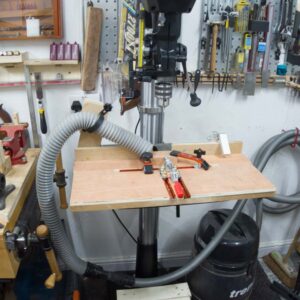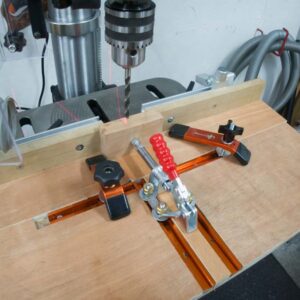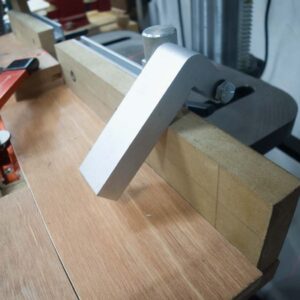The Nova voyager drill press is an expensive item, so deserves to be made the most of to justify the expense. And it is surprising how often a drill press gets involved in making all kinds of furniture or other wooden stuff – not just the drilling but the sanding …. and I wonder what else?
As there seems to be a number of Nova drill press users here in the forum, I wonder if we could share our various accessory-modes that illustrate various ways to use these fine machines?
Myself, I’ve so far made a basic MDF + plywood table to go on top of the metal table, mounted on the Nova fence. The Nova fence attaches the wooden table to the metal table but allows the whole thing to be slid back & forth; or even rotated somewhat. The wooden table caters to various hold-downs, an adjustable-position dust extraction hose, as well as a removable insert to prevent underside break-out of drilled wooden parts.
Pics are attached. I’ve tried to minimize the amount of T-track inset in the table for mounting hold-downs of various kinds, to those areas that a table I used on my previous drill press stand revealed as the only T-track actually used. The whole thing dismounts from the Nova fence and table via four flush-head bolts going through the backboard into T-nuts sliding in the Nova fence’s T-track.
One issue is that the Nova fence length-stop can no longer get down to table-top level, as the backboard prevents it. I’ll be making a new further-articulated arm from rock maple to replace the Nova aluminium arm.
*******
Next, a drum sanding addition.
Can I persuade any other drill press accessorisers out there to post a pic or three of their drill press additions – Nova or other drill press brands?
Lataxe



















Replies
I've never had a decent drill press table. I usually use a scrap of plywood as a backer, and chuck it when it's no good.
I'd love to see ideas for a table that has replaceable inserts for backing up holes.
The table I made for the Voyager is primarily a rectangle of 19mm (3/4") MDF that's about 2/3rds the depth of the voyager's own table and about 1.5X wider. It also has a fence "wall" of the same stuff which attaches to the Nova drill press fence T-track, making it easy to remove the whole caboodle so that the Voyager metal table and fence can be used bare (e.g. with a vise or different hold downs).
The top of this supplementary MDF table has more T-track glued and screwed to it, for mounting hold-downs of various kinds. These T-tracks are surrounded by pieces of stuck-down 11mm plywood so that the T-tracks are just below the table surface. I used 3M spray glue to stick the plywood to the MDF, to avoid any distortions that wet glue might cause.
One of the stuck-down pieces of plywood is a 75mm X 100mm (3" X 4") piece that fits under the chuck and goes a little way into the Nova aluminium fence cut out. This is not stuck down but is a tight fit between the plywood that is stuck down. This is the sacrificial piece that lies under the drilling area whereon the workpiece is situated, to prevent breakout.
I made several spares of this 3" X 4" piece, as the plywood was a half sheet of rescued scrap, although it's of reasonable quality - flat enough for this purpose, anyway.
The sacrificial piece can be reversed and turned over to get the maximum use out of each piece before it gets too holed to work properly.
Derek Cohen has an arrangement in which his sacrificial piece is circular. He gets more use out of this by rotating it just a bit to provide an un-holed area. He reckons this gives more service (allows more holes) before it becomes too ragged to be effective. I'd like to try that but I haven't yet got the fly cutter to make the round hole and the round pieces to fit in it. There's one in the post, though. :-)
*********
A fence, hold-downs, a length stop and a sacrificial breakout preventer do make a big difference to the accuracy of one's 'oles. Yes. Perhaps just as important, they make things a lot safer. Whilst a suddenly rotating workpiece is not as dangerous as a bare circular saw blade waiting to take off fingers or even a whole hand, I have suffered a number of nasty clonks, bruises and possibly a broken finger from untethered wood lumps under a drill press suddenly deciding to cast off my grip so they can try being a propeller. No longer!
Lataxe
Here’s my replaceable insert setup and extra blanks. Used a router and chisels to mortise out the square.
Dumb suggestion: Offset the sacrificial square insert. Then you have 4 opportunities to have a fresh flat surface. Easier than making a circular one.
Offset is already accomplished by rotating the table to a new center. Not obvious in the pic, but the fence is also adjustable to almost 25*deg either way so long workpieces don't have to be drilled perpendicular to the drill presses footprint. It's a small shop solution that seems to work well.
More pics.
The supplementary table sacrificial insert is shown removed.
For extra light directed on to the workpiece, I use a small Bosch LED light that takes their 12V batteries, since I have a couple of their 12V tools and therefore 4 of the batteries.
This wee light has an articulating stand that also has a magnet built in, so it sticks to the Voyager or any other machine's metal case or surface at any angle. The light itself also articulates with reference to it's stand. Two light levels are available: nearly-blinding & see-every-dust-speck.
The old vise from the previous drill stand has migrated to the Voyager for use on the bare steel table. It has the useful facility of standing square in any of three orientations, on one of it's three machined-flat & square surfaces.
Lataxe
A sanding drum arrangement is being evolved. At present it's just two bits of MDF, one with a lower bearing for the drum and t'other providing a hole for the lower end of the drum to go in so that workpieces are sanded up-drum a bit. The lower bearing takes the sideways strain off the drill's arbour.
I hope to evolve this arrangement by using it to see if the MDF parts should be re-shaped. At the very least, two more holes in the upper part, for a 40mm and 25mm drum respectively, need to be made.
These sanding drums are made by a firm called Hope and can also be used on a lathe. They're very well engineered and very substantial. Various bits make up the system.
https://bivenmachinerysales.co.uk/product/hope-aluminum-drum-sander/
The sandpaper (Indasa Rhynogrip) is attached via hook and loop (the sandpaper having the loops). The stuff seems very well made, with very sticky loops and less inclination to clog than most drum sander grits.
Lataxe
Keep going to flea markets till you find a two directional "milling machine table".They go by lots of names.Yhen mount a double thick 3/4 inch top leaving enough space to move the table as far back as the screw adjustment lets you.Consider extending the table back by cutting a relief the depth of the post and three times as wide to handle the inevitable odd shaped piece.You will need a vice also. You will bless the two directional movement every time you want a drill bit to go into the location you laid out
'Morning Paul,
Yes, a back & forth table and/or vise does appeal. Long ago I had a standard-issue floor-standing drill press that did have such a vise mounted on its table. In those days I'd failed to realise the requirement for well-engineered items, so both the drill press and the vise were too crude & sloppy for getting the positional precision that you suggest would be a blessing.
But now that I know what to look for in the way of such a vise .... and have the precision drill press to mount it on ..... . Alas, the flea markets and similar in the disUK are not so fat with such useful items as proper machinists tables. Still, new ones may be bought if one can spare the arm & leg. Is Christmas near yet? :-)
Lataxe, currently playing with a circle cutter.
This forum post is now archived. Commenting has been disabled